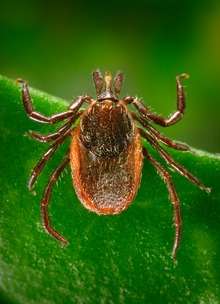Ixodes pacificus
| Ixodes pacificus | |
|---|---|
 | |
| Scientific classification | |
| Kingdom: | Animalia |
| Phylum: | Arthropoda |
| Class: | Arachnida |
| Order: | Acari |
| Family: | Ixodidae |
| Genus: | Ixodes |
| Species: | I. pacificus |
| Binomial name | |
| I. pacificus Cooley & Kohls, 1943 | |
 | |
Ixodes pacificus, the Western black-legged tick, is a species of Ixodes, a parasitic tick found on the western coast of North America. It is the principal vector of Lyme Disease in that region.[1][2]
Description
Belonging to the family Ixodidae, the western black-legged tick is considered a slow-feeding hard tick which possesses a plated body armor.[3] It is primarily found in the western region of the United States, particularly in northern California[4], and in southwestern Canada.
An adult male is around 2.54 mm in size, oval-shaped, and brownish-black in color. Due to the presence of a scutum on the dorsal side of the male, they are unable to feed in large quantities. Therefore, males of this species are unable to become engorged.[5]
An unfed adult female is around 3.18 mm in size, has a brown-black plate on the anterior back, an orange abdomen, and forward-projecting mouth-parts which enable feeding. While feeding, the adult female may engorge and expand to 9.5 mm or longer.[3]
Range
I. pacificus is found in the western region of the United States and in southwestern Canada. Although most prevalent in California, the tick has also been found in five other western states. These include Oregon, Washington, Utah, Nevada, and Arizona.[6] I. Pacificus has also been recorded in British Columbia[7]
Habitat
Nymphs
Nymphal stage ticks prefer a habitat consisting of dense woodlands with many leaves and areas littered with fir needles. It is most common to encounter western black-legged tick nymphs in areas with large amounts of shed leaves on the ground. This life stage of the tick may be encountered when humans are in direct contact with logs, branches, and shed leaves. These locations are where nymphal ticks seek out hosts.[3]
Adults
Both adult females and males prefer a habitat with an abundance of short vegetation. They may be found in grasslands, woodland grass, or brush areas. Unlike nymphal ticks, adult western black-legged ticks prefer to climb vegetation and wait for hosts to pass by. As such, these ticks are commonly encountered in open grasslands, at the border of trails in parklands, and in areas that are able to maintain a deer population.[3]
Life Cycle
The life cycle of Ixodes pacificus consists of four life stages: egg, larva, nymph, and adult. It takes approximately three years for the tick to complete its life cycle.[8]
Larvae, which emerge from eggs after approximately 53-55 days, take blood meals from vertebrates, such as lizards and birds. Protein from the blood meals, during the 4-10 day feeding period, enable the larvae to transform into immature nymphs after approximately 37-38 days.[5] In order for the nymph to reach the adult stage, they continue to feed for 7-11 days on the blood of vertebrates. After 30 days, an adult tick emerges. Female adults will consume blood meals from medium and large-sized mammals, and then deposit eggs in areas of leaf litter or soil.[6] Female adult ticks can deposit between 790 and 1,300 eggs over a period of 33-40 days.[5]
Disease Transmission
The western black-legged tick is a vector for Lyme disease, which is caused by infection with Borrelia burgdorferi. After feeding on a host animal infected with the bacterium, the tick is then able to transmit it to other animals, including humans, through subsequent blood meals. The nymphal stage, and sometimes adult female ticks, are responsible for the majority of transmission events. Nymphal ticks primarily feed on small animals and humans during the spring and early summer, while adult ticks are most active during the winter and seek out hosts from late fall to spring.[3]
In order for a human to be infected by the bacterium, the tick carrying it must be attached for approximately 36 to 48 hours. Due to the smaller size of the nymphal stage ticks, approximately 2 mm, they are more likely to go unnoticed when attached to a human. This enables a nymph to potentially stay attached longer to the host it is feeding on. For this reason, the nymphal stage is primarily responsible for transmission of Borrelia burgdorferi.[9]
References
- ↑ Chang CC, Chomel BB, Kasten RW, Romano V, Tietze N (April 2001). "Molecular evidence of Bartonella spp. in questing adult Ixodes pacificus ticks in California". J. Clin. Microbiol. 39 (4): 1221–6. doi:10.1128/JCM.39.4.1221-1226.2001. PMC 87914. PMID 11283031.
- ↑ Killilea ME, Swei A, Lane RS, Briggs CJ, Ostfeld RS (June 2008). "Spatial dynamics of lyme disease: a review". EcoHealth. 5 (2): 167–95. CiteSeerX 10.1.1.580.8928. doi:10.1007/s10393-008-0171-3. PMID 18787920.
- 1 2 3 4 5 Lyme Disease in California, Lane, RS and Kjemtrup, AM, University of California Agriculture and Natural Resources, 2016.
- ↑ Western blacklegged tick(Ixodes pacificus), Center for Disease Control and Prevention
- 1 2 3 Arthur, DR; Snow, KR (1968). "Ixodes pacificus Cooley and Kohls, 1943: its life-history and occurrence". Parasitology. 58 (4): 893–906. doi:10.1017/S0031182000069663. PMID 5693986.
- 1 2 Eisen, RJ; Beard, CB (2016). "County-scale distribution of Ixodes scapularis and Ixodes pacificus (Acari: Ixodidae) in the continental United States". Journal of Medical Entomology. 53 (2): 349–386. doi:10.1093/jme/tjv237. PMC 4844559. PMID 26783367.
- ↑ "Ticks and Lyme Disease". www.interiorhealth.ca. Retrieved 2018-05-11.
- ↑ Padgett, KA; Lane, RS (2001). "Life cycle of Ixodes pacificus (Acari: Ixodidae): timing of developmental processes under field and laboratory conditions". Journal of Medical Entomology. 38 (5): 684–693. doi:10.1603/0022-2585-38.5.684.
- ↑ "Transmission - Lyme Disease". Centers for Disease Control and Prevention.
- "Ixodes pacificus". NCBI Taxonomy Browser. 29930.
External links

